
| 纯度 | >90%SDS-PAGE. |
| 种属 | Human |
| 靶点 | ZNF391 |
| Uniprot No | Q9UJN7 |
| 内毒素 | < 0.01EU/μg |
| 表达宿主 | E.coli |
| 表达区间 | 1-358 aa |
| 活性数据 | MESLRGNTAQ GPTNEEDYKN EGQLSRQTKC PAQKKSSFEN TVVRKVSVTL KEIFTGEEGP ESSEFSLSPN LDAQQKIPKG HGSPISRKNS KDNSDLIKHQ RLFSQRKPCK CNECEKAFSY QSDLLVHSRI HGGEKPFECN KCGKSFSRST HLIEHQRTHT GEKPYECNEC GKAFSRSTHL SLHQRIHTGE KPYECSECGK AFSRSTNLSQ HQRTHTQERP YKCNECGKAF GDRSTIIQHQ RIHTGENPYE CSKCGKAFSW ISSLTEHQRT HTGENPYECS ECGKVFSRSS SLTEHQRIHS GEKPHECRVC GKGFSRSSSL IIHQRTHTGE KPYKCNDCGK AFCQSSTLIR HQHLHTKE |
| 分子量 | 40.6 kDa |
| 蛋白标签 | His tag N-Terminus |
| 缓冲液 | PBS, pH7.4, containing 0.01% SKL, 1mM DTT, 5% Trehalose and Proclin300. |
| 稳定性 & 储存条件 | Lyophilized protein should be stored at ≤ -20°C, stable for one year after receipt. Reconstituted protein solution can be stored at 2-8°C for 2-7 days. Aliquots of reconstituted samples are stable at ≤ -20°C for 3 months. |
| 复溶 | Always centrifuge tubes before opening.Do not mix by vortex or pipetting. It is not recommended to reconstitute to a concentration less than 100μg/ml. Dissolve the lyophilized protein in distilled water. Please aliquot the reconstituted solution to minimize freeze-thaw cycles. |
以下是3篇关于重组人ZNF391蛋白的假设性参考文献(基于领域内相关研究内容的合理推测):
---
1. **文献名称**: "ZNF391 encodes a transcriptional repressor modulating cell proliferation in cancer"
**作者**: Liao, W. et al.
**摘要**: 该研究通过蛋白质纯化及ChIP-seq发现,ZNF391通过结合靶基因启动子区的特定序列抑制其转录,在肺癌细胞中调控细胞周期相关基因表达,其表达水平与患者生存率呈负相关。
---
2. **文献名称**: "Structural insights into the DNA-binding mechanism of ZNF391"
**作者**: Kim, S. & Patel, D.J.
**摘要**: 通过X射线晶体学解析ZNF391锌指结构域与DNA结合的分子机制,揭示其C2H2型锌指模块特异识别5'-GCNG-3'序列,为设计靶向ZNF391的小分子抑制剂提供结构基础。
---
3. **文献名称**: "ZNF391 interacts with TP53 and promotes genomic instability in colorectal cancer"
**作者**: Zhang, Y. et al.
**摘要**: 发现ZNF391与TP53蛋白直接结合,干扰其抑癌功能,导致结直肠癌细胞DNA修复能力下降及染色体异常,临床样本分析显示高表达ZNF391与化疗耐药性显著相关。
---
**注**:以上为模拟内容,ZNF391的实际研究文献需通过PubMed/Google Scholar等平台检索确认。该蛋白研究尚属前沿,建议关注近5年发表的论文以获取最新进展。
Zinc finger protein 391 (ZNF391), a member of the C2H2 zinc finger protein family, is a transcription factor characterized by tandem arrays of zinc finger motifs that mediate sequence-specific DNA binding. This protein is encoded by the ZNF391 gene located on human chromosome 6p22.1 and shares homology with other ZNF family members involved in transcriptional regulation, chromatin remodeling, and cellular differentiation. While its precise biological functions remain incompletely understood, ZNF391 is hypothesized to participate in gene expression modulation through interactions with promoter regions or other regulatory elements. Studies suggest potential roles in cell cycle control, apoptosis, and developmental processes, though mechanistic insights are limited.
Recombinant human ZNF391 protein is typically produced using bacterial or mammalian expression systems, enabling in vitro studies of its DNA-binding properties, protein-protein interactions, and regulatory networks. Its recombinant form is often tagged (e.g., GST, His-tag) for purification and detection. Research applications include elucidating its involvement in diseases such as cancers or neurological disorders, where aberrant expression of zinc finger proteins is frequently observed. Epigenetic studies also explore ZNF391’s potential as a biomarker or therapeutic target. Despite progress, the protein’s full spectrum of molecular targets and pathways requires further investigation to define its physiological and pathological significance.
×